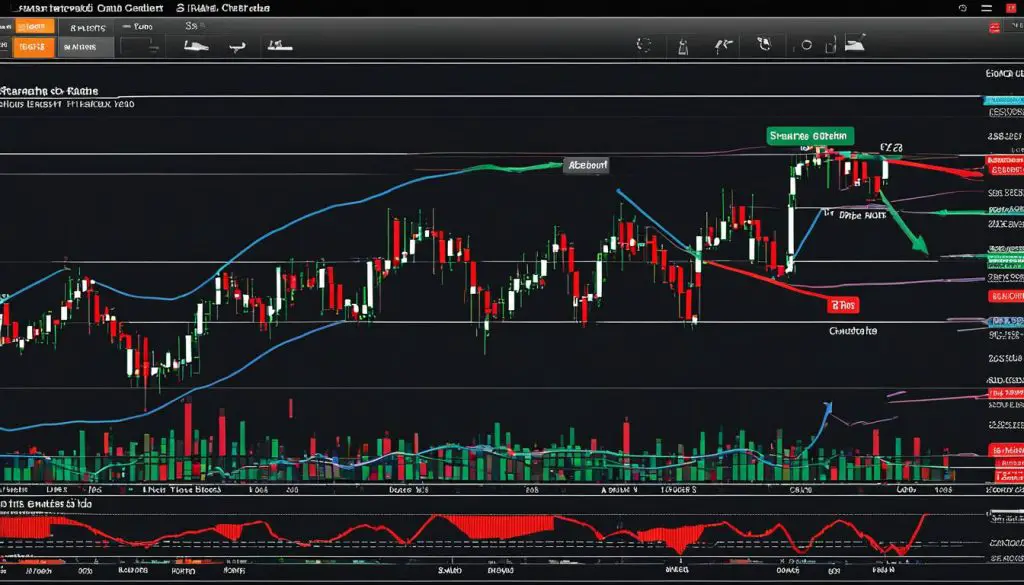As traders navigate the complexities of the financial markets, technical analysis remains a cornerstone for crafting sophisticated trading strategies. Among the myriad of tools at their disposal, the bollinger band stop indicator emerges as a formidable ally, enhancing market timing with its dynamic approach to volatility. Originally conceptualized by John Bollinger in the 1980s, this versatile indicator has cemented its place across diverse markets, offering users valuable insights into stock, future, and currency fluctuations. With its ability to gauge overbought and oversold conditions, bolster trend following, and monitor breakouts, the Bollinger Band stop indicator is an indispensable asset for traders seeking to finesse their market interventions.
Whether the goal is to pinpoint market momentum or to identify potential reversals, the construction of the Bollinger Band—with its three critical lines—provides a framework within which traders can interpret movements and make calculated decisions. The central feature, a 20-day simple moving average, flanked by bands that adapt to standard deviation shifts, serves as a navigational tool through the ever-changing tides of market speculation. In the hands of an astute trader, the Bollinger Band stop indicator is not just a technical analysis tool; it is the compass by which successful trading strategies are charted in the turbulent sea of the financial markets.
The Basics of Bollinger Bands for Market Analysis
The exploration of Bollinger Bands as a pivotal tool in stock market analysis inevitably involves understanding their structure and underlying mathematical computations. These bands have become synonymous with the assessment of volatility—a dynamic aspect of the financial markets that can signal major shifts in pricing direction. Recognizing these principles is fundamental for investors and traders eyeing to harness the predictive capabilities of Bollinger Bands.
Understanding the Construction and Calculation of Bollinger Bands
At the heart of the Bollinger Band formula lies a simple yet profound concept: the standard deviation of stock prices over a specific period, which quantifies the extent of price movements relative to an average. Here is an overview of how these bands are constructed:
- The middle band is a 20-day simple moving average of the stock’s price.
- The upper band adds to the middle line a value that is typically two standard deviations of the price.
- The lower band subtracts the same value of two standard deviations from the middle band.
While these parameters are the norm, traders can customize the multiplier (the number by which the standard deviation is multiplied) and the period of the moving average to fit their specific strategies and the stock’s unique volatility profile.
How Bollinger Bands Can Indicate Overbought and Oversold Levels
Bollinger Bands are more than just measures of volatility; they’re indicators of potential market actions ahead. Here’s how:
- Overbought Conditions: When stock prices push above the upper band, the market may be considered overextended to the upside and due for a correction.
- Oversold Conditions: Conversely, if prices drop below the lower band, stocks may be undervalued, suggesting a bounce back could be forthcoming.
These scenarios revolve around the concept of mean reversion, which implies that prices tend to revert back to the average over time. Alert to these conditions, traders incorporate Bollinger Bands into their strategies for both trend identification and meticulous risk management.
Adapting Bollinger Bands to Different Market Conditions
Recognizing the versatility of Bollinger Bands is key for trend traders who must adapt their tools to fluctuating market conditions and volatility levels. Adjustable settings allow for tailored volatility-based trend assessments and trading signals:
- Creating multiple bands with various standard deviation multipliers can indicate more or less aggressive trade zones.
- Dynamic responses to market conditions are achieved when the bands expand and contract with evolving price action and market uncertainty.
Combined with other market analysis tools, Bollinger Bands provide traders with rich insights for their decision-making processes, aiding in the fine-tuning of both entry and exit points as part of a comprehensive trading strategy.
Strategic Applications of the Bollinger Band Stop Indicator
When it comes to enhancing trading strategies, the Bollinger Band squeeze strategy stands out for its predictive prowess. The approach focuses on moments of lower volatility, denoted by the narrowing of Bollinger Bands, which often suggests a coming surge in price movement. By recognizing these patterns, traders are armed with the foresight to anticipate significant trading signals and the impetus for potential breakouts.
The comparison between Bollinger vs. Keltner channels is another tactical application that aids traders in selecting the most fitting volatility indicator for their respective trading philosophies. Where Bollinger Bands use standard deviation, Keltner Channels rely on the average true range to measure market volatility, offering a different perspective on market dynamics. These insights inform traders on which indicator may best align with their market outlook and strategy execution.
The strategic employment of these tools requires not solely an understanding of their technical construction but also the ability to interpret their outputs effectively. Traders often set stop-loss orders to manage risk upon entering positions guided by breakout signals. Here is an example comparing the functionalities and uses of both the Bollinger Bands and Keltner Channels:
| Bollinger Bands | Keltner Channels |
|---|---|
| Utilizes standard deviation to gauge volatility | Employs average true range for volatility metrics |
| Offers dynamic adjustment to price swings and volatility | Provides smoother channel movements |
| Effective for spotting the Bollinger Bands squeeze | Valuable for recognizing trend continuations or reversals |
| Sensitive to sudden market changes | Less prone to giving false breakout signals |
By leveraging the intrinsic strengths of these indicators—Bollinger Bands for their responsiveness and Keltner Channels for their trend-following clarity—traders can refine their approach to capture profitable trading signals while mitigating risks. Proper understanding and application of these instruments ensure traders can navigate even the most unpredictable financial waters with confidence.
Utilizing Bollinger Bands for Trend Identification
Successful traders consistently emphasize the importance of trend identification and market timing to maximize their investment yields. Bollinger Bands have emerged as a pivotal instrument in achieving these strategic objectives in trading. We will delve into the intricacies of these techniques, showcasing the use of Bollinger Bands in capturing market trends and enhancing trading outcomes.
Significance of the Band Width in Trend Analysis
The measurement of the band width is a fundamental aspect of market volatility assessment. It’s a critical indicator that provides foresight into imminent market movements. A significant widening of the bands marks increased market volatility, often a precursor to a trend onset. In contrast, a contraction of the bands signals reduced volatility and may foreshadow a period of market consolidation or a potential trend reversal. Assessing these patterns empowers traders with key insights into trend potency and overall market sentiment, which are indispensable for precise market timing.
Identifying the Trend Direction with Bollinger Bands
Ascertaining the direction of a trend is pivotal for any trade decision. The Bollinger Band breakout strategy revolves around the price action in relation to these bands. Typically, in an uptrend scenario, prices will hover above the middle Bollinger Band, furnishing a bullish sentiment indicator. Conversely, when prices linger below the middle band, it points toward a bearish inclination. Such observable patterns become actionable intelligence for trend traders, propelling them to engage with the prevailing market course, by leveraging breakouts as confirmatory signals for trend continuity.
| Trend Type | Position Relative to Middle Band | Implication for Traders |
|---|---|---|
| Bullish | Above Middle Band | Consider long positions, monitor for continuation patterns |
| Bearish | Below Middle Band | Opportunity for short positions, lookout for reversal signals |
| Volatility Increase | Bands Widening | Prepare for potential trend formation or significant price moves |
| Volatility Decrease | Bands Narrowing | Anticipate market consolidation or reversal |
The prowess of Bollinger Bands in trend identification lies in the versatility of the tool to adapt its readings in real-time, aligning with both swift and gradual market shifts. Traders harness this dynamic attribute for superior market timing, adjusting strategies swiftly to benefit from emerging trends or to sidestep potential downturns. Bollinger Bands continue to stand as an essential element in the arsenal of effective traders.
Advanced Bollinger Band Strategies for Traders
The utilization of advanced techniques involving Bollinger Bands has revolutionized the approach to navigating the financial markets. Experienced traders have long recognized the potential of these strategies to forecast significant market moves and optimize entry and exit points during periods of high volatility. Among these, the Bollinger Band squeeze is a noteworthy event that signals a tightening of the bands, denoting a future surge in price movement – a crucial moment for traders focusing on breakout trades.
The Bollinger Band Squeeze and Breakout Trades
A constricted Bollinger Band, or ‘squeeze’, suggests a hushed before the tempest in market conditions. It is a prelude to an anticipated increase in volatility, followed closely by a breakout. This setup becomes a strategic bet for traders who, by discerning the bands’ convergence, are alerted to the potential of a dominant price move. Embraced within a trader’s arsenal, these breakout trades seize upon this phase of market compression and is considered a precursor to a substantial price move.
Combining Bollinger Bands with Other Technical Indicators
For an enhanced trading edge, pairing Bollinger Bands with other technical indicators has become a trusted method amongst traders. Supplements such as the Relative Strength Index (RSI), Moving Average Convergence Divergence (MACD), and the Stochastic Oscillator, when used in conjunction with Bollinger Bands, provide a fortified view of market shifts. These indicators serve as an affirmation of the momentum indicated by the Bollinger Bands, enabling traders to validate their predictions and refine their strategies with an elevated degree of confidence.






